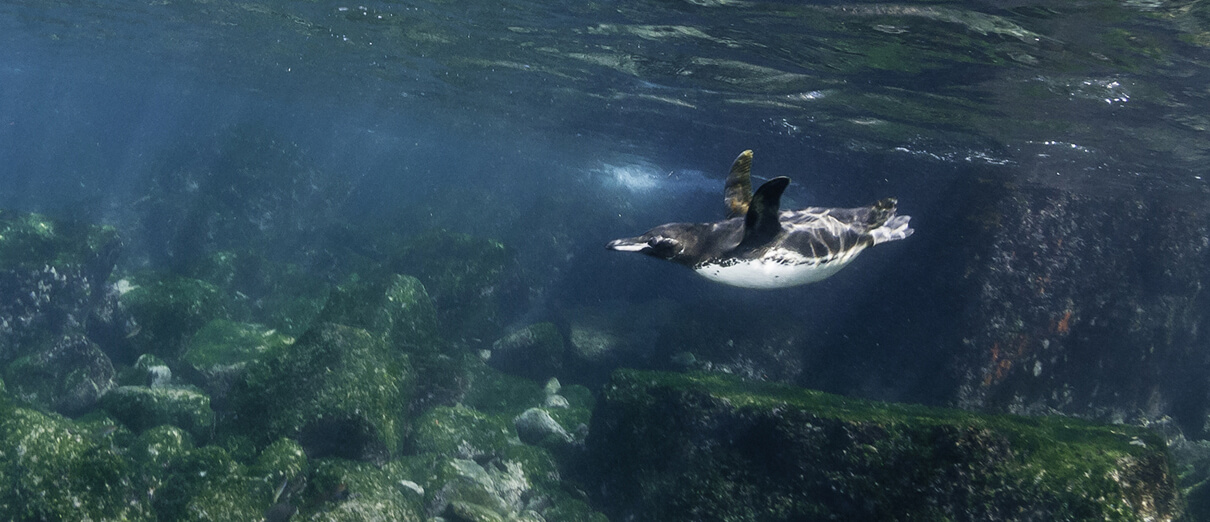
The Galapagos Penguin is the smallest South American penguin, and the only one to live near the equator. It shares the Galápagos Archipelago with other seabirds such as the Galapagos Petrel and Waved Albatross. It is the most northerly-breeding penguin species in the world, living around the equator. In fact, a small part of the population actually lives just north of the equator. This species is closely related to Magellanic, Humboldt, and African Penguins, which are found further south, although none of these are Antarctic.
Unique Adaptations
The Galapagos Penguin has a number of physical and behavioral adaptations that help it keep cool. Its small size — no more than 20 inches in height — allows it to squeeze into small caves and crevasses to hide from the strong equatorial sun. In addition, bare patches on its face and behaviors such as panting and standing with flippers extended also help it to release heat.
Equatorial Penguin
Approximately 95 percent of the Galapagos Penguin's population is found on Isabela and Fernandina, two islands in the western part of the archipelago. There, cool waters of the Humboldt and Cromwell Currents well up and sweep along the shores, nourishing a high density of fish prey that sustains this species year-round.
The Galapagos Penguin's call is a distinctive honking bray, given mainly on the breeding grounds. This vocalization helps individuals to identify both their mates and their chicks.
(Audio: Jesse Fagan, XC383122. Accessible at www.xeno-canto.org/383122)
Penguin Parenthood
Galapagos Penguins breed in loose colonies in the cracks and caves of the islands' lava flows. They mate for life, and reinforce their pair-bonds through behaviors such as mutual preening and bill dueling. These penguins are opportunistic breeders, nesting when food is plentiful — probably an adaptation to their unpredictable environment. If conditions are favorable, Galapagos Penguins will breed two to three times per year.
Once mated, the female lays up to two eggs, and both parents help with incubation. One parent is always present to incubate while the other goes out to forage. After the chicks have hatched, one parent continues to remain at the nest until the chicks are around three weeks old. Both parents then head out to sea, bringing back food for their rapidly growing and always ravenous chicks.
Fishing Techniques
Like the Peruvian Diving-petrel, Inca Tern, and many other equatorial seabirds and other marine creatures, the Galapagos Penguin relies upon the cool temperatures of the Humboldt and Cromwell Currents to provide a rich supply of prey year-round.
This penguin feeds close to shore on small fish such as sardines, mullet, and anchovies. It often hunts by diving down over 90 feet, below fish schools, then grabbing its prey as it rises to the surface. It also picks off stray fish. The penguin's attacks from below push fish schools close to the surface, creating feeding opportunities for other birds such as the Brown Pelican, Brown Noddy, and Flightless Cormorant, another interesting bird found only on the Galápagos Islands.

Galapagos Penguin by wildestanimal/Shutterstock
Recovering Penguin Populations
The main threat facing this unique penguin is the increasing frequency of El Niño Southern Oscillation (ENSO) events, perhaps due to or exacerbated by climate change. These events reduce food availability and lead to low reproduction or starvation of colonies.
Other threats to the Galapagos Penguin include drowning after entanglement in gillnets; oil spills; predation by introduced cats; and avian malaria, which is carried by mosquitoes brought to the Galápagos by humans in the 1980s.
ABC's Seabird Program works to address threats faced by the Galapagos Penguin and other ocean-going birds, including puffins and the Laysan Albatross and Pink-footed Shearwater. One of the main challenges is eliminating and reducing risks posed by fisheries.
Since the entire Galapagos Penguin population is found within the Galápagos National Park and Marine Reserve, it is annually monitored by park biologists and rangers, who also work to control introduced predators. A program that provides artificial nest sites, begun in 2010, has shown some success and may help maintain this species' population.



















































